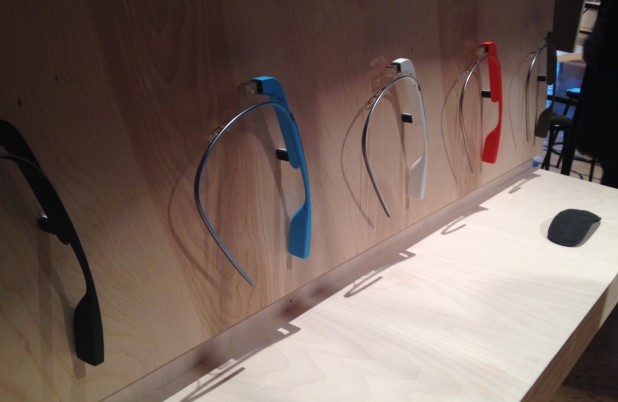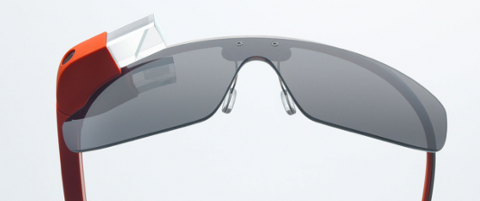[caption id="attachment_16136" align="aligncenter" width="618"]  A Glass rack at a Google Glass studio in NYC.[/caption] The Google Glass studio above New York City’s Chelsea Market is modeled after an ultra-chic boutique, all white walls and blonde wood and helpful assistants who murmur in soothing tones as they adjust the Google Glass to fit your head. “OK Glass,” you say, reading the words on the tiny screen embedded in the right lens, and the headset offers a list of potential commands: translate, get directions, send a message, take a picture, Google something random. You choose directions, read off an address, and a map appears onscreen, complete with a blue line heading crosstown to your destination. Take the elevator down to the ground floor and head outside. As you trot north, the Fitbit or Nike FuelBand strapped to your left wrist offers up a steady stream of data on your distance traveled, calories burned, elapsed time walking, and other metrics. When you arrive at your destination, you pull out your smartphone and spend a few minutes checking your email, Twitter feeds, Facebook messages, and a half-dozen app updates. For decades, the term “cyborg” has evoked images of robots with a human’s outward appearance: the T-800 and T-1000 from the Terminator movies, or the Cylons in the Battlestar Galactica reboot. Over the past few years, a handful of artists and thinkers have experimented with mechanical implants that boost our everyday abilities; for example, the New York University professor who had a small camera inserted into the back of his skull, connected via cable to a computer in a shoulder-bag. The experimentation has extended beyond humans, with organizations such as DARPA toying with the idea of “insect-cyborgs.” The robots are coming, and they are us. Many people greet the idea of cybernetic implants with disdain and maybe a little fear. “Humanity is really going bonkers,” wrote one commenter to the CNN story about the NYU professor who turned himself into a tri-eyed wonder. “This just creeps me out,” wrote another a few minutes later. (Comparatively few seemed to support the experiment.) Yet even as we rebel against the idea of robotic enhancement, we’re becoming cyborgs of a subtler sort: the advent of smartphones and wearable electronics has augmented our abilities in ways that would seem superhuman to humans of even a couple decades ago, all without us having to swap out a limb or neuron-bundle for their synthetic equivalents. Instead, we slip on our wristbands and smart-watches and augmented-reality headsets, tuck our increasingly powerful smartphones into our pockets, and off we go—the world’s knowledge a voice-command away, our body-metrics and daily activity displayable with a few button-taps. That hardware will evolve into more sophisticated forms in coming years. Whereas current health-monitoring wristbands are fairly constrained in their collective feature-sets and analytical abilities, for example, their successors might do everything from reading your heartbeat to predicting when you’re about to have a major medical emergency. “If you go back a few hundred years, what we take for granted today would seem like magic—being able to talk to people over long distances, to transmit images, flying, accessing vast amounts of data like an oracle,” Tesla and SpaceX CEO Elon Musk told Forbes in 2012. “These are all things that would have been considered magic a few hundred years ago.” But there’s a dark side to that free-flowing data and the convenience that comes with it, as Edward Snowden’s whistleblowing revealed in the summer of 2013. “If you use your smart toothbrush, the data can be immediately sent to your dentist and your insurance company,” public intellectual Evgeny Morozov explained to the Los Angeles Times, “but it also allows someone from the NSA to know what was in your mouth three weeks ago.” The more we depend on devices, the more our lives hinge on the companies providing the equipment. The cyborgs in movies tend to be all-powerful beings: think Arnold Schwarzenegger hurling some poor sap through a wall, or the Borg assimilating everything in sight. It’s a little bit ironic, then, that the wearable devices that make us cyborg-like could also render us weaker: more gizmos connected to more databases exposes more of our personal information to criminal hacks and government data-mining; more software capable of more tasks has weakened, at least according to some pundits, our ability to concentrate and cognate. Our technology has transformed us into some of the most powerful human beings to ever live; but it’s also made us some of the most vulnerable, as well. Image: Nick Kolakowski
A Glass rack at a Google Glass studio in NYC.[/caption] The Google Glass studio above New York City’s Chelsea Market is modeled after an ultra-chic boutique, all white walls and blonde wood and helpful assistants who murmur in soothing tones as they adjust the Google Glass to fit your head. “OK Glass,” you say, reading the words on the tiny screen embedded in the right lens, and the headset offers a list of potential commands: translate, get directions, send a message, take a picture, Google something random. You choose directions, read off an address, and a map appears onscreen, complete with a blue line heading crosstown to your destination. Take the elevator down to the ground floor and head outside. As you trot north, the Fitbit or Nike FuelBand strapped to your left wrist offers up a steady stream of data on your distance traveled, calories burned, elapsed time walking, and other metrics. When you arrive at your destination, you pull out your smartphone and spend a few minutes checking your email, Twitter feeds, Facebook messages, and a half-dozen app updates. For decades, the term “cyborg” has evoked images of robots with a human’s outward appearance: the T-800 and T-1000 from the Terminator movies, or the Cylons in the Battlestar Galactica reboot. Over the past few years, a handful of artists and thinkers have experimented with mechanical implants that boost our everyday abilities; for example, the New York University professor who had a small camera inserted into the back of his skull, connected via cable to a computer in a shoulder-bag. The experimentation has extended beyond humans, with organizations such as DARPA toying with the idea of “insect-cyborgs.” The robots are coming, and they are us. Many people greet the idea of cybernetic implants with disdain and maybe a little fear. “Humanity is really going bonkers,” wrote one commenter to the CNN story about the NYU professor who turned himself into a tri-eyed wonder. “This just creeps me out,” wrote another a few minutes later. (Comparatively few seemed to support the experiment.) Yet even as we rebel against the idea of robotic enhancement, we’re becoming cyborgs of a subtler sort: the advent of smartphones and wearable electronics has augmented our abilities in ways that would seem superhuman to humans of even a couple decades ago, all without us having to swap out a limb or neuron-bundle for their synthetic equivalents. Instead, we slip on our wristbands and smart-watches and augmented-reality headsets, tuck our increasingly powerful smartphones into our pockets, and off we go—the world’s knowledge a voice-command away, our body-metrics and daily activity displayable with a few button-taps. That hardware will evolve into more sophisticated forms in coming years. Whereas current health-monitoring wristbands are fairly constrained in their collective feature-sets and analytical abilities, for example, their successors might do everything from reading your heartbeat to predicting when you’re about to have a major medical emergency. “If you go back a few hundred years, what we take for granted today would seem like magic—being able to talk to people over long distances, to transmit images, flying, accessing vast amounts of data like an oracle,” Tesla and SpaceX CEO Elon Musk told Forbes in 2012. “These are all things that would have been considered magic a few hundred years ago.” But there’s a dark side to that free-flowing data and the convenience that comes with it, as Edward Snowden’s whistleblowing revealed in the summer of 2013. “If you use your smart toothbrush, the data can be immediately sent to your dentist and your insurance company,” public intellectual Evgeny Morozov explained to the Los Angeles Times, “but it also allows someone from the NSA to know what was in your mouth three weeks ago.” The more we depend on devices, the more our lives hinge on the companies providing the equipment. The cyborgs in movies tend to be all-powerful beings: think Arnold Schwarzenegger hurling some poor sap through a wall, or the Borg assimilating everything in sight. It’s a little bit ironic, then, that the wearable devices that make us cyborg-like could also render us weaker: more gizmos connected to more databases exposes more of our personal information to criminal hacks and government data-mining; more software capable of more tasks has weakened, at least according to some pundits, our ability to concentrate and cognate. Our technology has transformed us into some of the most powerful human beings to ever live; but it’s also made us some of the most vulnerable, as well. Image: Nick Kolakowski


